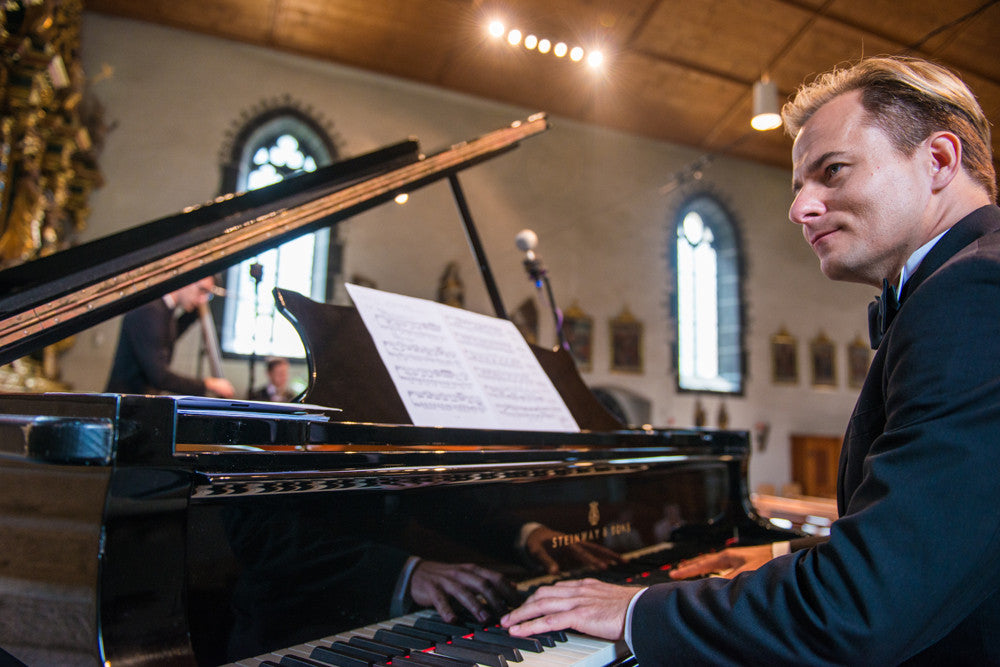
Cross-over Jazz: The Charl du Plessis Trio
As luck would have it this morning, I ran into pianist Charl du Plessis on the lovely Dorfplatz, the central square in Ernen that’s more or less the aorta of the village. Last evening, du Plessis and the other members of his trio − Werner Spies, stick bass, and Hugo Radyn, drums − had knocked the socks off listeners in the jazz program they brought to this year’s Musikdorf Ernen festival. Performing in the main concert venue of the village church, the three musicians came on stage in elegant tuxedos, a modern take on the chasubles and miters clerics might have worn before their Catholic parishioners earlier. Given the repertoire they broke into, however, the three musicians shone just as brightly as the gold gilt alters that stood behind them and also flanked their stage.
The trio had performed a year ago here in Ernen, and had cut a CD in the meantime to commemorate that performance. Du Plessis’s introduction was in German; He explained to the packed pews of the concert audience that he would play the classical pieces that were the trio’s springboard material first, then explore new territory with the rhythms and nuances of a newer genre. He then sat down to play cross-over jazz in a way I’d never heard before, and that on a piano that once belonged to the great conductor, Bernard Haitink!
An adaptation of Vivaldi’s “Autumn” was first on the program. The familiar melody of the Allegro was given its delightful due, even if within minute or two, the pianist pulled in syncopated rhythms to foreshadow what was to come, where the bass that would “ground” the baroque sound with tremendous pulp and resonance. The piano periodically entertained a dialogue with the otherworldly; the tinkling of keys being a reminder either of magical days gone by or still yet to come. What struck me in the slow movement, Adagio molto, was base player’s Spies’s fluid and able finger work on the neck of his instrument: indeed, his long digits looked almost like those of an underwater creature scuttling across the ocean floor. The final Allegro alternated elements of free jazz with what felt like the strains of easy listening.
Two of du Plessis’s original compositions – Waltz sum more” and “Pay with Samba” came next, each one a little more than 5 minutes long. The pianist had said the first would be a kind of “massage for the ears,” the second might be “a dance with the heart.” Rightly so; while each required terrific instrumental competence, both were built around a degree of saccharin romance I mostly associate with feature film scores. Their beauty, though, was in their “sing-able” feature, namely those kind of melodies that travel with you wherever you go.
Next was an adaptation of Bach’s double violin concerto in D Minor (BMW 1043), something du Plessis hoped would be “so good that Bach wouldn’t recognize it.” That was partly in jest, of course; the pianist readily gave us enough of the Baroque master to see us settle down in our seats first. But in short order, he let the classical genre slip..
Read the full article: Cross-over Jazz: The Charl du Plessis Trio - Tuesday, 26 July 2016, by Sarah Batschelet
Find this album here (release: 14.10.16)
Related collections
Antonio Vivaldi
Double bass
Folk, popular & jazz
Georg Friedrich Händel
Johann Sebastian Bach
Piano
Popular products
Pre-order
Releases 2015 - 2017
Soon
Digital links
iTunes: http://apple.co/1rcTGXm
GooglePlay: http://bit.ly/25LQ8ON








Comments
0 Comments